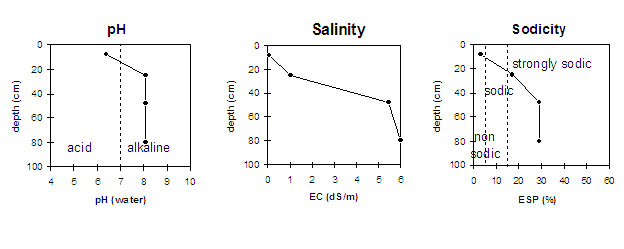LP4
This page is under construction and is not complete.
Soil Profile Morphology:
Surface Soil
Key Profile Features:
Soil Profile Characteristics:
Surface (A) Horizon
Subsoil (B) Horizons
Comments by Gyn Jones:
Profile Described By: John Martin, Mark Imhof and Sonia Thompson (1994)
Page top
| Location: Kerang East | Australian Soil Classification: |
| Northcote Factual Key: | Great Soil Group: |
| General Landscape Description: Flat plain. | Local Name: Macorna Clay. |
Soil Profile Morphology:
Surface Soil
| A1 | 0-15 cm | Dark brown (7.5YR3/4); medium heavy clay; cracking surface condition; very firm consistence moist; pH 6.4; sharp and smooth change to: | |
| Subsoil | |||
B21 | 15-35 cm | Yellowish red (5YR4/6); heavy clay; strong coarse prismatic, breaking down to strong medium polyhedral structure; very strong consistence dry; pH 8.1; gradual change to: | |
B22 | 35-60 cm | Strong brown (7.5YR5/6); medium clay; blocky structure; firm consistence dry; pH 8.1; gradual change to: | |
B23 | 60+ cm | Strong brown (7.5YR5/6); light medium clay; moderate lenticular structure; weak consistence moist; contains a common (10-20%) amount of calcium sulphate in clusters as well as a few (2-10%) dark segregations (3 mm in size); pH 8.1. | |
NOTE: At one metre depth there is gypsum accumulation within a salt deposit. | |||
Key Profile Features:
- High clay content throughout profile.
- Cracking surface condition.
- Vertic properties (i.e. significant shrink-swell characteristics).
Soil Profile Characteristics:
 |
Management Considerations:
Whole Profile
- The inherent fertility of the surface soil is moderate increasing to high in the subsoil which is beneficial to plant growth.
Surface (A) Horizon
- When the soil is dry, heavy rains will move down soil cracks. This rapid recharge can be valuable for the survival of plants near wilting. When wet, the soil will swell and further infiltration will be relatively slow.
- Tillage of cracking clay soils should be avoided if the soil is wet (i.e. wetter than the plastic limit). At such a moisture condition, excessive tillage, trafficking or overstocking can result in structural degradation (e.g. compaction, smearing) occurring. Ideally, tillage should take place on clay soils such as these when the soil is drier than the plastic limit, down to at0least the tillage depth.
- The surface (A1) horizon is non-sodic without dispersion after immersion in water. This is probably due to the high exchangeable calcium levels. However, there is strong dispersion after the soil is remoulded and immersed in water. This indicates that some structural degradation may occur if cultivation occurs when the soil is wet.
- The levels of organic carbon measured at the surface (A1) is moderate (this may or may not be representative of the whole paddock) and the inherent fertility is also moderate which is beneficial for plant growth.
- The levels of total nitrogen measured at this pit site is high. However, this is best assessed by taking a bulked sample from across the paddock.
Subsoil (B) Horizons
- The densely and coarsely structured subsoil is strongly sodic with a low exchangeable calcium to magnesium ratio (0.6) and complete dispersion after remoulding. This indicates that root and water movement will be significantly restricted in the upper subsoil. The deeper subsoil is strongly sodic with nil dispersion probably due to the extremely high salt levels.
- The extremely high salinity at 40 cm is likely to restrict the growth of salt sensitive plant species (e.g. faba beans, linseed, chickpeas and lupins).
- The high level of exchangeable sodium and magnesium in the deeper subsoil (B22 and B23) may also result in nutrient imbalances and may also have a toxic effect on some plants.
- The subsoil displays vertic properties which indicates that significant shrinking and swelling occurs with wetting and drying cycles. This may disturb the roots of some plant species and has engineering implications (e.g. disturbance to building foundations and fence lines).
Comments by Gyn Jones:
- Gyn considers drainage to be via preferred pathways i.e. old root channels where it seems to be in a stairway like pattern. Gypsum works well on the upper subsoil (B21) horizon where water drainage is limited however drainage improves in the layer (B22) below.
- The soil requires two inches of rainfall for water holding capacity.
- The deeper subsoil (B23) layer seems to be from an earlier soil formation.
Profile Described By: John Martin, Mark Imhof and Sonia Thompson (1994)


